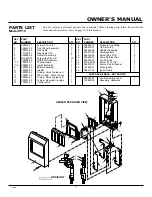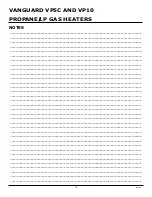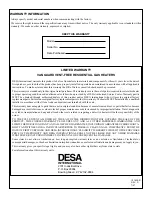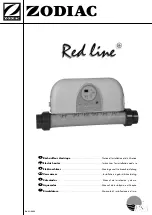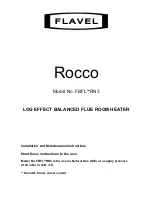
101850
OWNER’S MANUAL
13
OBSERVED PROBLEM
ODS/pilot lights but flame goes out when
control knob is released
POSSIBLE CAUSE
1.
Control knob not fully pressed in
2.
Control knob not pressed in long
enough
3.
Manual shutoff valve not fully open
4.
Thermocouple connection loose at con-
trol valve
5.
Pilot flame not touching thermocouple,
which allows thermocouple to cool,
causing pilot flame to go out. This prob-
lem could be caused by one or both of
the following:
A) Low gas pressure
B) Dirty or partially clogged ODS/
pilot
6.
Thermocouple damaged
7.
Control valve damaged
TROUBLESHOOTING
Continued
REMEDY
1.
Press in control knob fully
2.
After ODS/pilot lights, keep control
knob pressed in 10 seconds
3.
Fully open manual shut-off valve
4.
Hand tighten until snug, then tighten
1/4 turn more
5.
A) Contact local propane/LP gas com-
pany
B) Clean ODS/pilot (see Cleaning and
Maintenance, page 11) or replace ODS/
pilot assembly
6.
Replace thermocouple
7.
Replace control valve
Burner(s) does not light after ODS/pilot is
lit
Delayed ignition of burner(s)
Burner backfiring during combustion
Burner plaque(s) does not glow
Slight smoke or odor during initial opera-
tion
Heater produces a clicking/ticking noise
just after burner is lit or shut off
1.
Clean burner orifice(s) (see Cleaning
and Maintenance, page 11) or replace
burner orifice(s)
2.
Replace burner orifice(s)
3.
Contact local propane/LP gas company
1.
Contact local propane/LP gas company
2.
Clean burner orifice(s) (see Cleaning
and Maintenance, page 11) or replace
burner orifice(s)
1.
Clean burner orifice(s) (see Cleaning
and Maintenance, page 11) or replace
burner orifice(s)
2.
Contact local propane/LP gas company
3.
Replace burner
4.
Replace gas regulator
1.
Replace burner
2.
Contact local propane/LP gas company
3.
Turn control knob until it locks at de-
sired setting
1.
Problem will stop after a few hours of
operation
1.
This is common with most heaters. If
noise is excessive, contact qualified
service person
1.
Burner orifice(s) is clogged
2.
Burner orifice(s) diameter is too small
3.
Inlet gas pressure is too low
1.
Manifold pressure is too low
2.
Burner orifice(s) is clogged
1.
Burner orifice(s) is clogged or damaged
2.
Inlet gas pressure is too low
3.
Burner damaged
4.
Gas regulator defective
1.
Plaque damaged
2.
Inlet gas pressure is too low
3.
Control knob set between locked posi-
tions
1.
Residues from manufacturing pro-
cesses
1.
Metal expanding while heating or con-
tracting while cooling

















